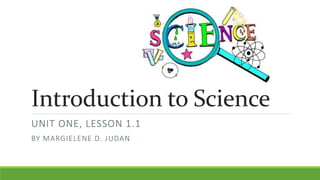
Unit 1, Lesson 1.1 - Introduction to Science
- 1. Introduction to Science UNIT ONE, LESSON 1.1 BY MARGIELENE D. JUDAN
- 2. LESSON OUTLINE What is Science? Science as a Body of Knowledge Science as a Product and a Process Limits of Science
- 3. What comes to your mind when you hear the word “SCIENCE”?
- 5. Lab Coats/ Lab Gowns
- 6. Microscopes
- 7. Astronomer looking in space through his telescope
- 9. Chemical Reactions in Beakers
- 10. Launching Rockets to Space
- 11. Or maybe even ETs and UFOs
- 12. All of those images reflect some aspect of science, but none of them provides a full picture because science has so many facets.
- 13. WHAT IS SCIENCE? -Latin word -scientia -means “having knowledge” WORD ORIGIN
- 14. WHAT IS SCIENCE? AS A BODY OF KNOWLEDGE Science is a systematized body of knowledge based on gathered facts, observation and experimentation. AS A PRODUCT AND A PROCESS Science as a product is an ever-changing body of knowledge. It is an ongoing process of investigating and thinking: 1. a way of thinking that involves reasoning, and 2. A way of investigating that involves questions, observations, experimentations, and predictions.
- 15. WHAT IS SCIENCE? AS A BODY OF KNOWLEDGE Based on Facts Observations Experiments AS A PRODUCT AND A PROCESS Way of Thinking which involves Way of Investigating which involves Reasoning Questions Observations Experiments Predictions SCIENTISTS ARE THOSE WHO STUDY SCIENCE TO CREATE SOLUTIONS TO PRESENT PROBLEMS IN ORDER TO MAKE LIFE EASIER.
- 16. LIMITS OF SCIENCE 1.Ethics and Morality 2.Mathematics 3.Reason 4.Why?
- 17. 1. Science doesn’t make moral judgments. (Ethics and Morality)
- 18. 2. Science doesn’t make aesthetic judgments. (Mathematics) Aesthetic- deals with nature of art, beauty, or taste. Science can’t tell us whether something is pleasing or not or whether a performance is beautiful or dreadful. You cannot measure someone’s talent.
- 19. 3. Science doesn’t tell you how to use scientific knowledge. (Reason) Science gives you facts, but it doesn’t teach you how to use them. Only you can teach yourself how to think!
- 20. 4. Science doesn’t draw conclusions about supernatural explanations. (Why?) By definition, science only studies the natural world. Therefore, any object/entity supernatural like God is not Science. Science doesn’t have all the answers.
- 21. Ponder upon with superstitions. Do you think they are true, reliable and scientific? Prove and give examples.
- 22. Now, that you are equipped with the basic concepts of Science, you’re now ready to go through Science 7! Welcome to the study of the natural world!
- 23. Additional: SO WHY STUDY SCIENCE? 1. It is fun! 2. It makes life easier. 3. Because knowledge is power.
- 24. Additional: WHAT TO BRING IN SCIENCE CLASS 1. Textbook and notebook 2. Pen and paper 3. Most of all, a working brain!